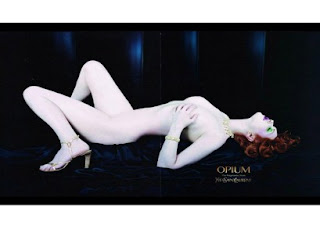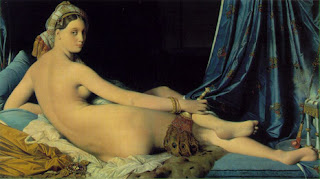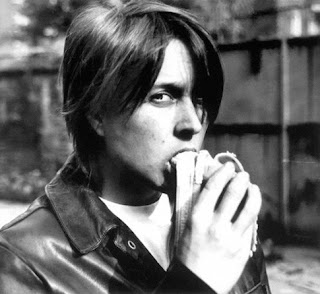helen.clarke@leeds-art.ac.uk
THE GAZE & THE MEDIA
"According to usage and conventions which are at last being questioned but have by no means been overcome - men act and women appear. Men look at women. Women watch themselves being looked at"
~ Berger, 1972
Women and their bodies in contemporary culture. Difficult for women not seeing themselves as being looked at. Always see women and images of women looking back, that they compare themselves too. Not an equivalent to men. Women always survey their idea of femininity.
Hans Memling "Vanity" 1485 - Women holds a mirror. Incorrectly rendered in reflection, women's face is her full face and inaccurate replication of a mirror, it should be reflecting side of her face. Distorted view of her face. In a way kind of get the image she sees when looking in a mirror. Mirror as a justification for the act of looking.
Alexandre Cabenel 'Birth of Venus' 1863.
Reclining on a wave. Covers her own head and hand, covering her eyes. The body vs the head, most of it is taken up by the naked body itself. Small section contains her head. Concentration of focus on body, not on her as a person. Relative to female photography in modern society.. such as...
Sophie Dahl - Opium
Advert was deemed too sexual for magazines/billboards. In a vertical image as it was published it takes emphasis of the sexual body position, your eyes roam to the face.
Titian's Venus of Urbino, 1538
Covers herself but in a very casual way.
Similar to Manet - Olympic, 1863. Very similar although 300 years later.
The cloth she's laying on is exquisite. Offered flowers by a slave/worker. Her necktie thing is symbolic of prostitutes. The difference between head positions of the two paintings, she's lifting the head as if she's addressing us. Period of Impressionism. Impressionism starts to use that snapshot style, in direct relation to the invention of photography.
Ingres 'Le Grand Odalisque' 1814
MANET - Bar at the Folies Bergeres 1882
Mirror gives an imposible reflection of the womans body. Reflected slightly to her right. Allows us to see her from two viewing positions at once, also see her as the character that is illuminated in the corner of the painting. What's also reflected behind her is the Paris society at the time. Idea of being looked at. Looking at us.
Jeff Wall "Picture For Women' 1979
Referenced again. The gaze has returned from the woman in the painting. We can also see a similar reflection, this time of the studio. Mirror itself is divided into 3 sections, the windows in the background are also divided. He's reminding us this is a studio. Return of the gaze.
In contemporary advertising.
Coward, R. (1984)
The camera in contemporay media has been put to use as an extension of the male gaze at women on the streets. The city kind of carries on regardless of her. No acknowledgement of her. This normalisation of nudity or semi-nudity is kind of a comment on billboards and media. We don't even take note of it anymore.
Eva Herzigova, 1994.
Traffic jams took place when this was on billboards. Normalisation of nudity on the street. Comedy of the line, seems to lighten the implication.
Peeping Tom, 1960.
A movie about a man who spies on women, constructs a system where he looks at women when they're undressing. His voyeurism leads to murder. Holds a camera with a mirror attached to it, seeks to take the image of the women as he kills her. For kicks. Idea of women as an object of desire
Men's bodies have also been used as objects for advertising.
Gender ads website http://www.genderads.com/
From 2007 - Dolce and Gabanna - men working out in a gym. Hairless, all greased up and looking at you. Idea of being strong
Laura Mulvey
Marilyn: William Travillas dress from The Seven Year Itch (1955)
Breaking a body down with the camera.
In the darkness of the cinema, auditorium. It's the pefect place to be voyeuristic, you can look anywhere you want and no one can see you. Everything's in the dark. The narcissistic process of association with an ideal ego seen on the streets.
Active male and passive female.
e.g.
Lara Croft: Tomb Raider
- A visual spectacle to be consumed
- Was an overly sexualised object
- Pleasure in the fantasy of her destruction
Artemisia Gentileschi - Judith Beheading Holofernes, 1620
Portrays women in a very powerful and graphic manner. Beheading a man, in a forceful and violent manner. Feel of a film still to the image. Actually in a dark room with them and it captures them.
G, Pollock 1981
Cindy Sherman "Untitled Film Still #6" 1977-79
Essentially a reclining figure, but turned the body round, like in the Sophie Dahl Opium advert. Rather than the emphasis being on the body, we are looking at the face - the characters face. Hand awkwardly placed on chin, not a natural movement, an awkwardness now. Associate that now with stage photography, staged to look like a captured movement when it's not.
Sarah Lucas, Eating A Banana, 1990
Challenging conventions and what we perceive by simple innocent acts.
Replacing female body associations with odd objects, without explicitly saying it.
Tracey Emin, Money Photo, 2001
Her work is self referential. All the money being made was possible a personal criticism of her. The girls almost stuffing the money inside her.
Amanda Knox - Witch? Are we living in 1486? Joan Smiths
The idea of women being natural liars has a long pedigree. Women being witches in past culture and beliefs, whereas men won't. A woman is beautiful to look upon, contaminating to the touch and deadly to keep.
Also claimed all withcraft comes from lust. Which in women is insatiable. Women are dangerous, although beautiful. Again women in culture being mistreated and thought of as objects.
Papers prepare two stories. One for guilty and not guilty. Mistakenly publishing the wrong online version of the Knox verdict.
Doesn't look "stunned".
Social networking is used to perpetuate the male gaze/the gaze of the media
The body is broken into fragments-could be any female. Plays on teenagers body consciousness, potentially carrying those perceptions into adult life.
Conspiracy theories. Real impact of this obsessive voyeurism. Not just a theoretical investigation.
Popularity of reality television.
- Appears to offer us the position as the all-seeing eye the power of the gaze
- voyeuristic passive consumption of a type of reality
- contestant are regarding themselves as objects of obsessiveness
THE TRUMAN SHOW (1988)
Investigation of what it would be like to be unaware, that his whole life is a reality tv show. Backdrop to his life is an actual stage.
Big Brother 2011
Design of the chair, shot is always from the knee to the head. Voyeurism style, focus on body. At one point even had cameras in the showers.


































0 comments:
Post a Comment